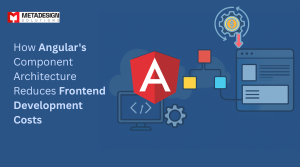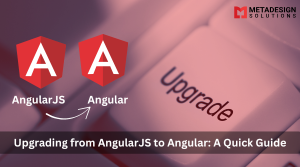I. Introduction: Mitigating Long-Term Risk
The Core Problem: The Decade of Debt
When budgeting for a new, large-scale application, most organizations focus intensely on the initial build cost. However, for true enterprise software, which often has a lifecycle spanning 5 to 10 years or more, the initial build is a fractional expense. The most significant financial drain is the decade of maintenance, bug fixing, mandatory upgrades, and team turnover that follows.
If your codebase decays, your costs will spiral.
The Failure of Flexibility
Many popular frontend solutions advertise extreme flexibility, allowing developers to mix and match libraries, state management solutions, and stylistic approaches. While this freedom is appealing for small projects, it quickly becomes a liability in an enterprise setting. This lack of guardrails often leads to heterogeneous codebases, ballooning technical debt, and expensive, unpredictable maintenance down the road.
Thesis Statement: Angular’s Rigidity is a Strategic Asset
Angular is an “opinionated” framework. It imposes structure, enforces patterns, and dictates the way to build applications. This initial rigidity is not a barrier to productivity; it is a strategic asset that delivers unmatched predictability, significantly lower Total Cost of Ownership (TCO), and superior stability for applications that must stand the test of time.
We will examine the three critical pillars that make Angular the lowest-risk investment for mission-critical applications: Architectural Discipline, Predictable Maintenance, and Enterprise Backing.
II. Pillar 1: Architectural Discipline and Team Efficiency
Angular’s rigorous, prescribed structure acts as a financial safeguard, dramatically slowing the decay of your codebase and maximizing team efficiency.
The Power of TypeScript: Catching Costs at Compilation
Angular’s native reliance on TypeScript, a superset of JavaScript that enforces static typing, is your primary defense against costly errors.
- Lowering Bug-Fix Costs: TypeScript catches common issues (like type mismatches or misspellings) during compilation, before the code ever leaves the developer’s machine. Bugs caught early are exponentially cheaper to fix than those discovered in QA or, worse, in production.
- Self-Documenting Code: TypeScript forces developers to explicitly define the structure and data types of inputs and outputs. This discipline creates self-documenting code that cuts down the onboarding time for new developers and ensures institutional knowledge transfer is smooth, regardless of staff turnover.
Opinionated Structure: Preventing “Spaghetti Code”
Angular is built around specific, clear concepts that prevent developers from inventing their own, often inconsistent, solutions:
- Modules and Standalone Components: Angular enforces clear organizational boundaries. Features are segregated into components, services, and modules (or standalone components), preventing logic from becoming tangled across the application. This architectural separation makes large codebases manageable.
- Inversion of Control (IoC) & Dependency Injection (DI): DI is fundamental to Angular. It forces components to request the services they need rather than creating them directly. This results in loose coupling, ensuring that an update to an Authentication Service won’t accidentally break a component consuming it, provided the interface remains stable.
Uniformity Across Teams
The Angular CLI and its prescriptive style guidelines mean that code written by a developer in your Boston office will look, feel, and behave identically to code written by an outsourced team in Bangalore. This uniformity is invaluable. It eliminates internal disputes over coding styles, reduces code review friction, and maximizes team mobility, allowing developers to switch between projects with minimal ramp-up time.
Ready to leverage AI in your Java products?
Hire LLM-skilled developers from MetaDesign Solutions today and elevate your products with cutting-edge AI integration for 2025!
III. Pillar 2: Predictable Maintenance and TCO
The single biggest determinant of TCO is how expensive and risky framework upgrades and patches are. Angular’s framework management is designed for the enterprise budget.
Scheduled and Stable Releases
Unpredictable major releases are a maintenance nightmare. Angular provides crucial planning confidence:
- Six-Month Major Release Cycle: Angular adheres to a transparent, six-month major release schedule. This predictability allows engineering leadership to plan, budget, and allocate resources for upgrades well in advance, minimizing disruption.
- Long-Term Support (LTS): Every major release is supported by a dedicated long-term support (LTS) policy for 18 months. This commitment guarantees that organizations will not be forced into a costly, premature rewrite and can remain on stable, supported ground.
Automated Upgrades with the CLI
The fear of a major framework upgrade paralyzes many organizations, often leading to technical stagnation. Angular eliminates this fear with the ng update command.
- Enterprise-Grade Tooling: The ng update command is an automated tool that executes common code migrations, structural refactorings, and dependency updates between major versions.
- The Benefit: This feature transforms what could be a manual, high-risk, week-long rewrite in other ecosystems into a relatively quick, scripted, and low-risk task. This alone is a massive saver on TCO.
A Robust Testing Ecosystem
Angular’s design is inherently testable. The framework’s dependency injection system allows developers to easily mock dependencies during unit testing, isolating component logic and allowing tests to run instantaneously. This integration leads to a high frequency of reliable unit tests, which, in turn, minimizes runtime risk and ensures higher code quality is maintained over the long run.
IV. Pillar 3: Enterprise Backing and Ecosystem
Long-term stability demands a powerful sponsor and a mature, feature-rich ecosystem.
Google’s Investment
Angular is developed and actively maintained by Google. This backing ensures its longevity, continuous performance optimizations, and integration with modern web standards. For executive decision-makers, this Google stewardship provides a crucial layer of trust and peace of mind regarding the framework’s future viability.
The Rich and Stable Ecosystem
Angular development services provides robust solutions for the common problems faced by enterprise developers, preventing the need to cobble together third-party libraries:
- RxJS for Reactive Programming: Angular natively utilizes RxJS for reactive programming, providing a powerful, standardized mechanism for handling complex asynchronous data flows (user inputs, HTTP requests, state changes). This consistency is vital for maintaining stability in data-intensive applications.
- Angular Material & Tools: The framework offers a vast library of professionally managed, accessible UI components (Angular Material). This prevents teams from having to build foundational UI elements from scratch, accelerating feature delivery and ensuring accessibility standards are met out of the box.
Performance for Enterprise
Angular incorporates performance optimizations essential for large applications, such as Ahead-of-Time (AOT) compilation (which compiles code before the browser downloads it) and tree-shaking (which removes unused code). These features ensure the resulting application bundles are small, highly efficient, and maintain their speed even as the feature set grows.
V. Conclusion: A Strategic Investment in Longevity
Angular is the choice for reliability, not for chasing the latest fad. It makes a conscious trade-off: a slightly steeper initial learning curve in exchange for exponential savings in long-term maintenance and risk reduction.
Choosing Angular is a strategic executive decision to prioritize low TCO and reduce technical risk. It allows your engineering team to focus on solving business problems rather than debugging architectural inconsistencies. In the world of enterprise UI, the most stable framework is inherently the most cost-effective one.
Are you planning a long-term enterprise application? Let’s discuss how a standardized, high-performance Angular architecture can future-proof your investment and guarantee predictability for years to come.
Related Hashtags:
#Angular #EnterpriseDevelopment #UIDevelopment #FrontendDevelopment #WebDevelopment #StableTech #LongTermSupport #ScalableUI #TechStack #JavaScript #TypeScript #GoogleAngular #SoftwareArchitecture #ReliableFramework #ModernWeb #DeveloperLife #ITSolutions #FutureProof #SinglePageApplication #SPADevelopment



